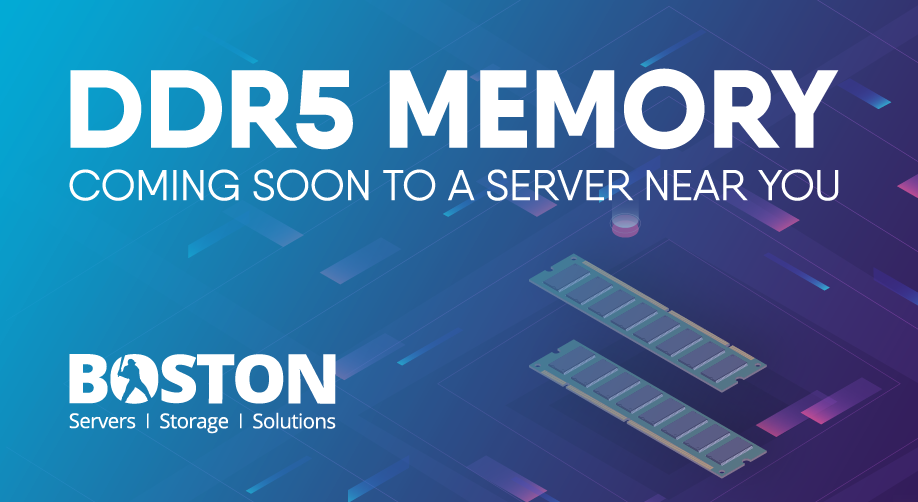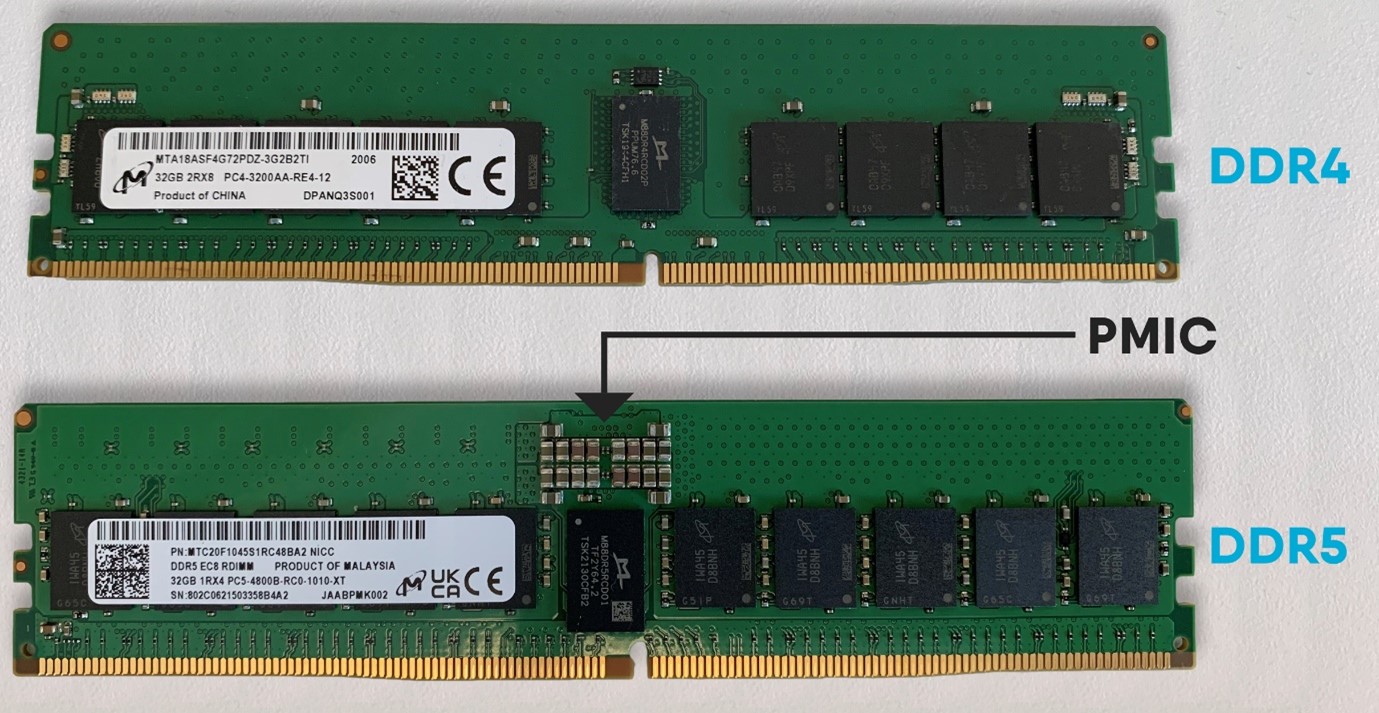
Introduction
Having launched in 2014, it feels like DDR4 has been around for long time. Eight years is a long time when you consider the advances in computer architecture year in year out. Whilst there have been increases in DDR4 technology along the way (faster performing modules), it does feel like the market is ready for the next evolution. This is especially the case for the server market where advances in technologies across products such as CPUs and storage media facilitate a need for memory with more capacity, faster memory bandwidth and higher data speeds as well as more power efficiency. DDR5 ticks all these boxes and more…
At Boston we design and build bespoke server solutions using the latest technology. DDR5 is sure to bring some worthwhile improvements to the server space. So, let's explore some of the key changes to get an idea of what to expect.

DDR5 ECC Registered DIMM - server grade module
Firstly, to support DDR5, the server must have CPUs, motherboards and chipsets that are DDR5 ready, and AMD and Intel will soon release server grade hardware that is ready to accomdate these. DDR5 is also not backwards compatible with DDR4 and has a new physical design. Whilst the memory is still in a 228-pin formfactor, DDR5’s layout of the pins is different so the DIMM’s cannot physically occupy the same type of slot as a DDR4 module.
I picked up both a DDR4 and DDR5 module from our Boston Labs to compare the layout for visual differences.

DDR4 module on the top, DDR5 on the bottom
Firstly, the keying notch is slightly more centralised on the DDR5 module, although it is still not exactly in the middle. The other notable difference is the highlighted Power Management Integrate Circuit (PMIC) cluster - this is the new power management circuits and capacitors that allow power regulation on the DIMMs rather than the motherboard, but we'll talk more about that later. Otherwise, it is business as usual with no significant physical changes. However, read on to see what changes and improvements make DDR5 a significant upgrade.
So, let us look at what most people will be interested in, how fast is this new memory?!
Speed
Of course, one of the main benefits of the DDR5 upgrade is going to be raw performance, with a significant increase in clock speeds in these chips.
The naming convention for memory modules can sometimes lead to confusion. For example, a DDR4 module, named DDR4-3200, has a data rate of 3200MT/s (million transfers per second) but the clock speed is half of this at 1600MHz, hence the nature of calling it Double Data Rate (DDR) memory. Doubling 1600MHz gives us our speed of 3200MT/s. Manufacturer part codes use memory module names showing the actual speed in MB/s. For example, a DDR4-3200 module would be named as PC4-25600 because the speed of such a module in Megabytes per second is actually 25,600MB/s. DDR4 uses a data bus that is 8 bytes (64-bit) so the peak transfer speed can be calculated by multiplying the data rate (MT/s) by 8. In our example, 3200 x8 = 25,600MB/s.
The DDR4 official JEDEC standard defined modules ranging from DDR4-1600 up to DDR4-3200 and this is what servers are currently maxing out at, with both Intel and AMD current server grade CPUs (Intel 3rd Gen Xeon Scalable and AMD EPYC™’s 2nd and 3rd gen CPUs) supporting up to 3200MHz. There are DDR4 memory faster than these specs, which are overclocked to give faster speeds. Vendors offer factory pre-overclocked memory running at faster speeds than the official DDR4 standard of up to 3200MT/s. These are used in specific systems such as gaming machines or rendering workstations, but typically servers are not designed to support overclocked memory in most cases.
DDR5 ups the ante with modules officially rated at DDR5-4800 which will scale up to DDR5-8400 eventually. So, we can see already the throughput is going to be a big step up. For example, the DDR5-4800 module will offer theoretically peak bandwidth of 38,400MB/s. DDR5 also uses 2x 32-bit buses for improved memory access efficiency.

DDR5 memory speeds
DRAM modules are made up of memory chips, and these in turn are sub divided into bank groups. Having more of these banks means faster access to memory. DDR4 has a 16-bank design, and this has been doubled to 32 for DDR5, thus increasing memory access speeds.
Burst rate has also doubled from DDR4’s 8 to 16 in DDR5. This results in faster burst transfers - the amount of data that can be accessed by a single read or write command.
Capacity
Die density is significantly raised with DDR5. Whereas DDR4 topped out at 16Gb memory chips, this resulted in mainstream modules of DDR4 going up to 64GB capacity. Manufacturers managed to up the capacity on these modules with various techniques such as squeezing more chips onto the memory module. For the server market, memory capacity is hugely important as hundreds of gigabytes, if not terabytes, are needed for memory hungry workloads. DDR4 offers single DIMM modules of 128GB for the server market. Samsung managed to squeeze even more chips onto the PCB with a monstrous 256GB module although this is somewhat of an outlier, and you can imagine the significant price tag that accompanies it.
DDR5 can support 64Gb memory chips and a capacity of 128GB-256GB is easily achievable per DIMM. Initially, the early DDR5 modules are using the same 16Gb chips as DDR4 with the higher capacity DIMMS being made available a little further down the line. Samsung have announced a 512GB DDR5 DIMM, made possible by stacking 8 x 16Gb memory chips on top of each other. This hugely increases density which will allow servers with DDR5 capability much more memory. In theory we could see modules of up to 2TB in the future, although this is some time away so 512GB is the achievable capacity for now. Both Intel’s and AMD’s upcoming server CPU refreshes will have DDR5 support (codenamed Intel Sapphire Rapids and AMD Genoa).

DDR5 memory capacity per DIMM
Power
Of course, faster speeds and denser memory chips can only mean one thing, more power being consumed. However, the DDR5 standard is designed with power saving measures in mind. The voltage has gone down from 1.2v to 1.1v when comparing DDR4 to DDR5. Of course, overclocked memory kits will raise this voltage just like in DDR4, but DDR5 will offer much higher speeds and features at lower voltages.
Another substantial change with DDR5 DIMMs is the power management will be on the memory module itself and not on the motherboard like with the DDR4. This is called the Power Management Integrate Circuit (PMIC) and is designed to regulate the power of all the components on the DIMM. This should lead to smarter and better voltage regulation and improved signal integrity (less noise). Server grade PMIC’s will be 12V whilst consumer grade is at 5V.
Summary
The below table helps to highlight the key differences between DDR4 and DDR5:

DDR4 vs DDR5
An interesting infographic from Micron below highlights the generational improvements to DDR memory. We can see a steady 300% density increase each time, but the leap from DDR4 to DDR5 has the biggest speed increase, at 163% when we reach 8400MT/s modules.

Image courtesy of Micron
Conclusion
We look forward to getting our hands on server grade DDR5 modules soon and will be sure to run some benchmarks in Boston Labs. It will be interesting to run some memory bandwidth benchmarks to see how much performance has improved in these new modules. With faster speeds and higher capacity DIMMs being developed over the next few years, supported alongside a new generation of CPUs, it is an exciting time for server memory.
Whilst servers capable of using DDR5 modules are not here yet, consumer grade DDR5 has certainly arrived. If you want to take an earlier leap into the next generation of memory, we have Intel Alder Lake (12th Gen Core and Pentium CPUs) Workstation solutions that can take advantage of these new DDR5 modules. If you would like to know more, please get in contact by emailing [email protected] or call us on 01727 876100 and one of our experienced technical sales team will gladly guide you through building the perfect solution just for you.
Author
Sukhdip Mander
Field Application Engineer